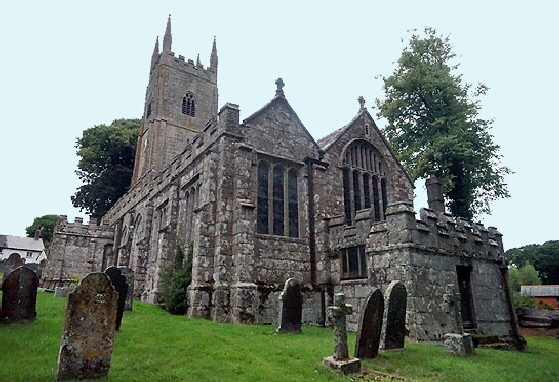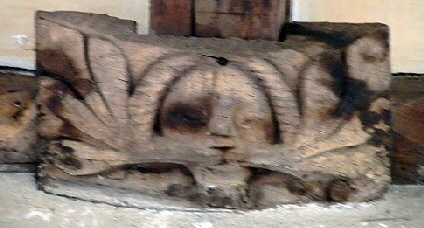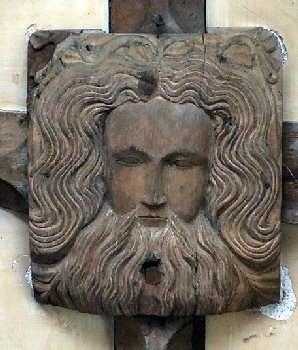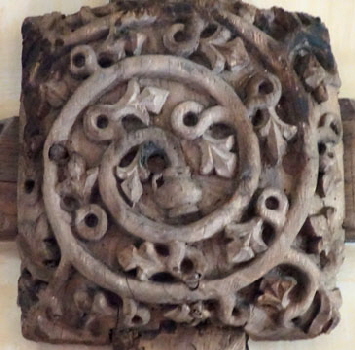|
Alphabetical List |
|
|
|
|
|
|
|
County List and Topics |
|
|
|
Please sign my Guestbook and leave feedback |
|
|
||||||||||||||||||||||||||||
|
suggesting that the original aisle was later extended eastwards. The arcades are of different stone: granite to the north and the finer grained Cornish Polyphant to the south. The east end is marred by the addition of a vestry. It is something of a carbuncle and why anyone would choose to site it here rather than on the more usual customary north side is a mystery. It has been battlemented in similar style to the rest of the church which must have seemed a good idea but which actually adds absurdity to misjudgment. Internally we see the usual West Country arrangement of three waggon roofs. Where you have waggon roofs you generally find carved bosses and where you find bosses you often find flamboyant carving and so it is here. To be sure most are quite anodyne but the south aisle gives us some real beauties with truly vibrant designs of the most robust rusticity. Not least of them are two examples of the so-called “tinner’s rabbits”, a clutch of green men such as you would not wish to meet in a dark alley after a few beers and a very in-your-face King and Queen. Really, they are wonderful examples of mediaeval rural art. It is interesting to reflect that roof bosses and bench ends are the canvasses upon which the West Country craftsmen carved their fantasies. In much of the rest of the country, particularly in the East Midlands where I live, it is the stonework which fulfilled that role. It’s not hard to see why. Just try carving gargoyles and grotesques out of granite! Beyond this, we have some bits and pieces of interest, not least the screen on the south side which was built using fragments of the original. Many Devon screens (but not, of course, their roods and carved figures) survived the Reformation but not at Sampford which, as we will see, resisted the Reformation with violence and insurrection. There are also some fragments of mediaeval glass. So what was Sampford Courtenay’s place in history? Well, it saw the first and acts of what is variously known as “The Western Rebellion” or the “Prayer Rebellion”. See the footnote for much more about that. |
 |
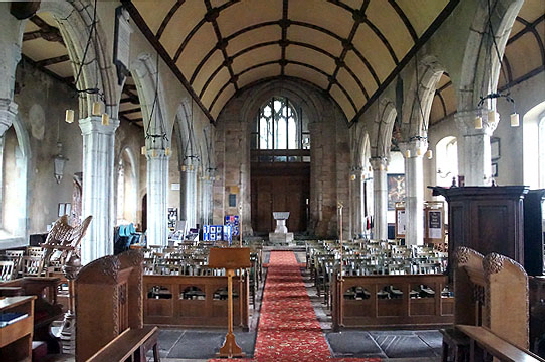 |
||
|
Left: The airy charm of this church strikes you as soon as you enter. The arcades and windows are large, the stone luminous, the ceilings painted. Note the “flexible” modern seating here. I don’t know what is replaced but the look of openness is quite obvious. More importantly, however, it enable the church to function as more than a place of worship. Right: The view to the west. |
 |
|||
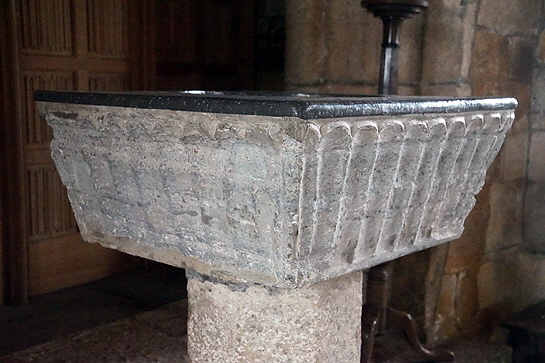 |
|||
|
Left: The twelfth century purbeck marble font. There are no true marbles in Britain. Like all of our pseudo-marbles it is in fact a carboniferous limestone that was popular in the richer churches and cathedrals up and down the land and in which you can often see the gazillion year old shells that formed this stone. Right: Fragments of mediaeval glass. |
 |
|||||
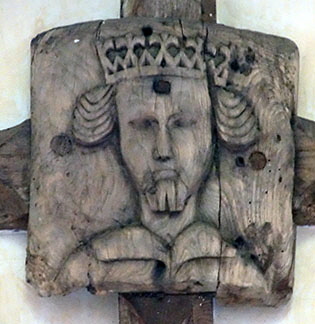 |
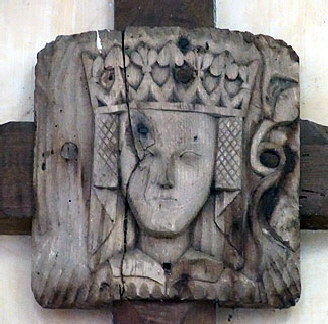 |
||||
|
Left and Centre: Roof bosses depicting a king and queen. But which king and queen? You see, these are very odd images. The dating of the church tell us that these carvings can be no earlier than 1450. It could, of course, be later. Yet the king has a beard. The king of 1450 was the sickly Henry VI but no contemporary picture has him sporting a beard. Ditto his usurper Edward IV. For good measure, neither did Henry V nor Richard III nor Henry VII. Henry VIII did. There is no reason why these bosses couldn’t be later than 1450. But look at that Queen. That is a headdress style that predates 1450. It most certainly is not a style that would have been worn by any of Henry VIII’s numerous queens nor by the queens of any of those kings I have mentioned. Against all of the chronology of this church these images are almost certainly (the bearded) Henry IV (reigned 1399-1413) and his queen Joanna of Navarre (1370-1437). She would have worn a headdress like this and and indeed her effigy in Canterbury Cathedral shows just that. Even more tellingly, the beard of the king has a cleft - as Henry IV’s contemporary pictures portray him. So what are the implications? One possibility is that the church building is older than previously supposed. Another is that the bosses were transferred from an earlier building either here or elsewhere - and note how those bosses are secured to the beams rather than being part of them. The third - and least likely by far - is that the carpenter just made something up to confuse us all. Right: This is also interesting. A sow is suckling her pigs. Why carve this? It could just reflect a local or personal preoccupation on the part of the carver. It is not unique but it is very rare - and at Sampford I think we can explain it. I think it derives from Saint Brannock who settled in Braunton thirty miles away. You can read about him in more detail here: https://ztevetevans.wordpress.com/tag/the-white-sow-and-seven-suckling-piglets/. To quote it briefly Brannock was told to seek a site “where a slow flowing stream flowed through a meadow where a white sow would be found suckling seven piglets. Pigs were thought to be a symbol of protection of the church and a mother with seven piglets was deemed very lucky. St Brannock searched and found the place where a white pig was suckling seven piglets and the church was built there which also the place where today’s parish church of St Brannock (Braunton) stands”. The carver here obviously had trouble fitting them all in but if you count the piglets there are...yes, seven! You may call me “Sherlock”.... |
 |
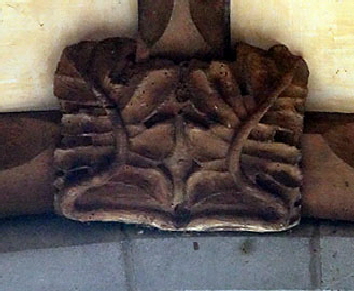 |
||||
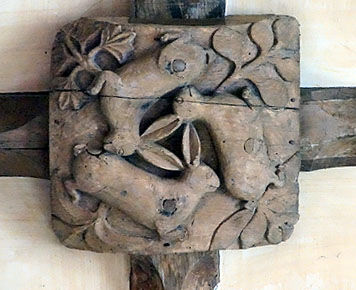 |
|||||
|
Left and Centre: Our journey into folklore continues as we see not one but two examples of carved “Tinner’s Rabbits”. The key element of this image is the way the rabbits manage to share three ears between them. The Church Guide retails the usual view that the image represents the “Trinity”. You can see another (painted) example at Widecombe-in-the-Moor also in Devon. There I also discuss the fact that this symbolism has been seen in seventh century wall painting in China and in Mongolia. It is seen in both Hindu and Muslim symbolism. I am sure that the “trinity” explanation is right - but it has been appropriated from many earlier cultures. In England it seems unique to Devon - unless, of course, you know otherwise....? Why are there two here, by the way? They are certainly not identical. Does it reinforce the possibility - see my discussion of the king a queen figures above - that some or all of the bosses actually came from elsewhere? Right: a much more mundane foliate carving which is the norm here. |
 |
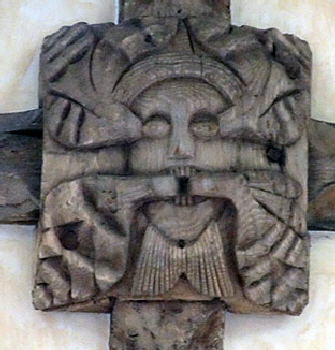 |
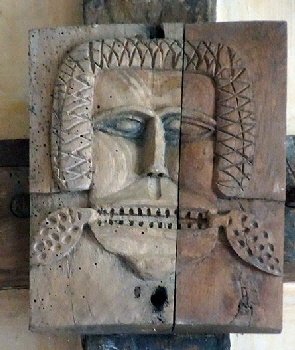 |
|
Three Green Men bosses. What an intriguing collection this is! They are all quite different and in the case of two of them the emphasis is on the “man” rather than the “green”. The one on the right is particularly crude. It seems to me that all of these are by different carvers. Did the carpenters all want to take a turn to show what they could do? Really it is the only logical explanation as to why there are three of them. |
|
|
||||||||||||||||||||
|
Above Centre: This, I think, is another green man. At first sight it is just an old man with flowing beard and locks. Look, however, at the top of his head and you see what look like “green” tendrils. This is rather a nice piece of carving. Above Right: A more mundane but high quality boss. |
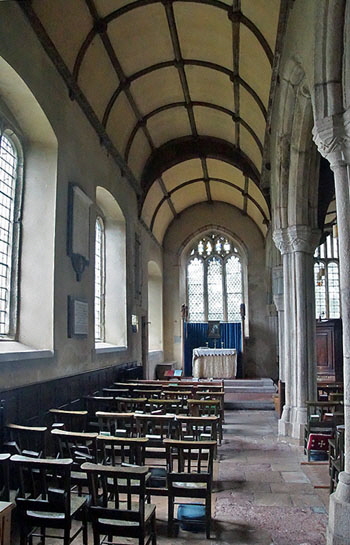 |
|||||
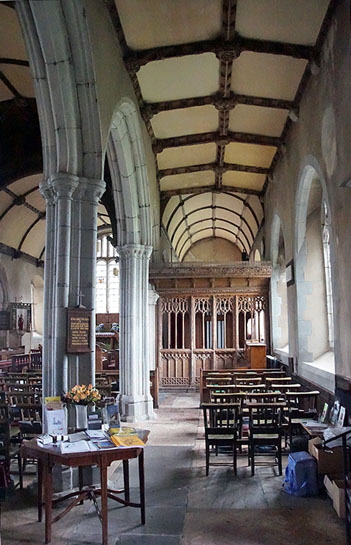 |
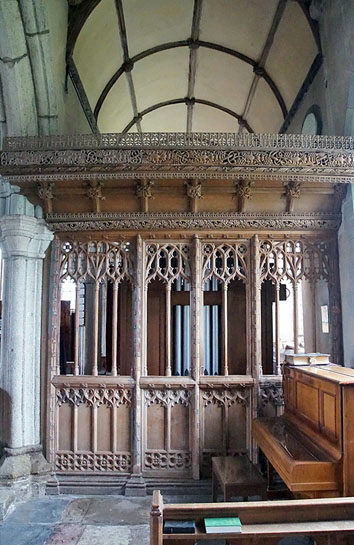 |
||||
|
Left: Looking along the south aisle to the screen and chapel beyond it. You can see that the aisle itself does not have a waggon roof, although the chapel beyond it does. This is a little odd since it seems that south aisle is contemporary with the other parts of the church, although I do think that the chapel itself was a later extension to it. Probably the ceiling was changed during a phase of Victorian restoration. Centre: The screen that used some salvaged parts of the original. Right: The north aisle, It is shorter than the south aisle, having only one bay into the chancel rather than the two on the south. Again, though, discontinuity in the ceiling hints at the aisle having been extended beyond the line of the chancel at a later date. |
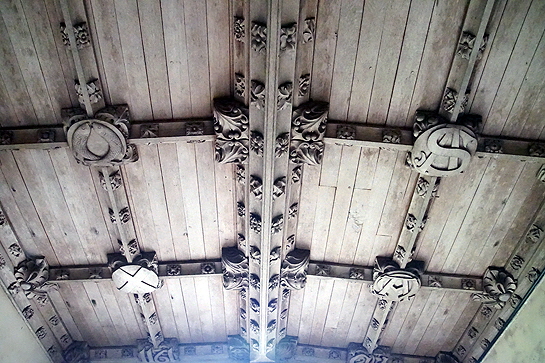 |
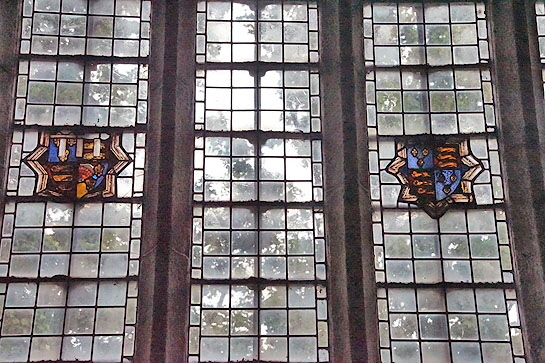 |
||||||||||||||||
|
Left: This is the ceiling of the south porch and it is very handsome. It also looks quite recent although there seems to be no information about it to be had. Right: This is a church with no stained glass beyond the few fragments of mediaeval glass that have been preserved. On the whole West Country churches didn’t go in for the Victorian stained glass that darkens (sometimes figuratively as well as literally!) many of our churches. Two fragments of coats of arms can be seen here. |
|||||||||||||||||
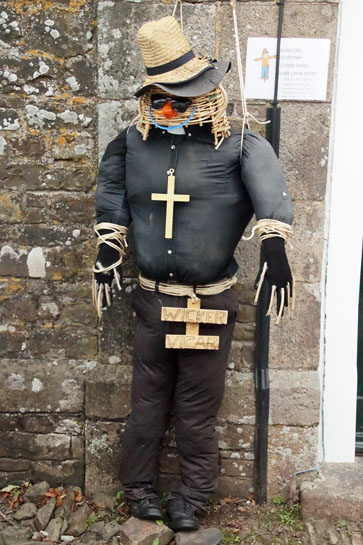 |
|||||||||||||||||
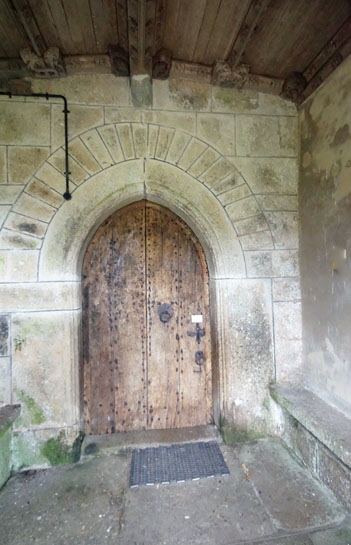 |
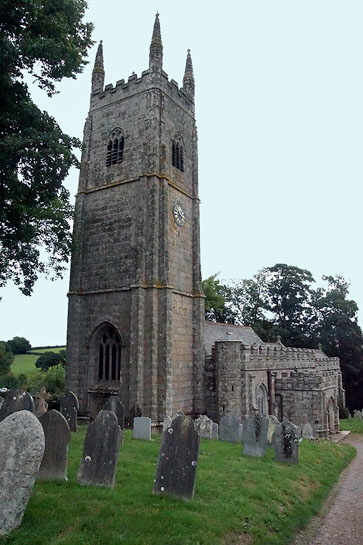 |
||||||||||||||||
|
Left: The south door. Note the sanctuary knocker and the roof bosses. Centre: The stately solidity of Sampford Courtenay church seen from the south west. Right: Scarecrow Festivals are one of the England’s more charming rural activities - and one that is growing in popularity. Sampford was holding one when we visited in August 2018 and I snapped this “Wicker Vicar” at a house just along from the church! |
|||||||||||||||||
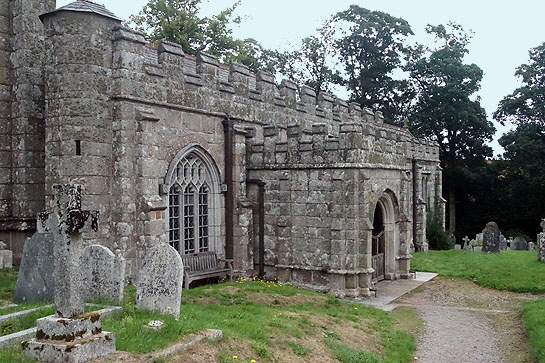 |
|||||||||||||||||
|
The church from the south west again. Note the noble perpendicular style (but maybe Victorian!) windows and the solid south porch. This is a church that took embattlement seriously. This is heavyweight crenellation. You almost expect a troop of archers to suddenly rise up and let fly! |
|||||||||||||||||
|
Footnote - The Prayer Book Rebellion and Some Observations on Popular Uprisings in England |
|||||||||||||||||
|
On the face of it there have been few rebellions in the history of Europe, never mind England, more difficult to understand than the Prayer Book Rebellion that started on the steps of Sampford Courtenay Church. As I have said on many of these pages, England’s adoption of the Protestant religion was not down to the sexually incontinent thug Henry VIII, although he of course created the possibility by usurping papal authority. Henry, nevertheless, died a Catholic. Just as few monarchs in English history have achieved fame so in excess of his achievements than Henry, few have had anonymity that so underplays his influence on our history than Henry’s son, Kind Edward VI. Henry, arguably closer to being a tyrant than almost any monarch in English history, enthrals us even today. The unfortunate Edward died at the age of sixteen and Hollywood just can’t bring themselves to make a film about him. So that’s that. Anonymity is his fate forever. Assuming the throne from the age of only nine, and sickly from his birth until his death at the age of sixteen, Edward was an ardent Protestant. Don’t be misled by his tender years: Edward was a considerable scholar. His Protector and uncle, Edward Seymour - Lord Somerset, was also a Protestant. It was during Edward’s brief seven year reign that England turned away from Catholicism - as opposed to the papacy - for the first time. His instrument of change was Archbishop Thomas Cranmer (1489-1556). Cranmer first became Archbishop of Canterbury under Henry, but his reforming zeal was tempered by the continuing struggle between conservatives and reformers. Combined with Henry’s own spiritual vacillations this produced an environment in which the beleaguered church-goer could find that what was orthodox today was heresy tomorrow. Edward’s accession changed the landscape for Cranmer who initiated the “reforms” that would influence both “The Church” and parish churches for centuries. Cranmer it was who decried the veneration of saints as “idolatry” and thereby produced the empty statue niches, defaced poppy heads and missing rood screens that we observe today. The two most important changes were the repeal of the doctrine of transubstantiation and the introduction of the Book of Common Prayer - in English. Roman Catholic believers will have to forgive me when I say that transubstantiation - the mysterious conversion of the bread and wine into the actual flesh and blood of Christ - was one of those doctrines that relied on ancient “interpretation” of biblical text. The same is true of the papacy as an institution. We can add to this the absence in the Bible of any mention of the concept of “Purgatory” that had been used to terrorise the laity (and to encourage their financial support for the Church) for centuries. The translation of the Bible into vernacular languages enabled people outside the clerical elite to discover or confirm the ambiguities and subjective interpretations that underpinned their faith and the liturgy. Not for nothing had the Church suppressed the translation of the Bible into vernacular language for centuries. For the average English rural peasant, the mysteries of the Mass and the Eucharist, the parrot-like repetition of the liturgy in a language they did not read, write or understand was part of the fabric of their existence. In a humdrum life, the beauty of the mass, the mystery of the Eucharist larded with arcane ritual, the celebration of the innumerable saints throughout the calendar year, must have been oases of spiritual uplift. In many ways they defined the lives of the common man. Cranmer changed all that. The Book of Common Prayer was now mandatory for all churches in England. The communion was merely symbolic. Numerous arcane and ostentatious liturgical practices were abolished. No weekly miracle for you, Bill Brewer, Jan Stewer, Peter Gurney, Peter Davey, Dan’l Whiddon, ‘Arry ‘Awke and Uncle Tom Cobleigh! The people didn’t like it. Indeed, eight of the eighteen bishops in the House of Lords didn’t like it either and - bravely perhaps - voted against it. For a readable account of the Prayer Book Rising I commend Peter Ackroyd’s “History of England Volume III - The Tudors” Chapter 19 “The Barns of Crediton”. Ackroyd recounts price inflation of 46% between 1540-7 and of 11% in 1549 alone. Landlords were enclosing land that was once held to be Common - stealing it, is another way of putting it. Smallholdings were being consolidated into larger farms outside the means of the peasantry. Arable lands that required a labour force became pasture lands that required, literally, one man and his dog. As it this were not enough, the coinage was being debased to the point that a “silver” shilling was worth little more than a groat - or four pence. In 1549 local riots began to break out, mainly against the enclosure of land in as many as ten counties. It was against this economic background that the Book of Common Prayer was to be used from Whit Sunday 9 June 1549. The penalty for dissenting priests was six months imprisonment and loss of position. Three strikes and you were out for lifetime imprisonment (a life likely to be very short in an English prison of the time). The priest of Sampford Courtenay, William Harper, carried out a somewhat watered-down version of the new liturgy on the Sunday. He was persuaded by dismayed parishioners that he should nevertheless celebrate the Mass in Latin on Whit Monday, which he duly did although we shall never know how much coercion was involved. The news spread throughout Devon and Cornwall and was celebrated by the ringing of bells and further resistance to the new ways. At Sampford Courtenay a local worthy, William Hellyon, tried to restore order and was hacked to death on the steps of the church room with a bill-hook for his pains. Ignominy and damnation was heaped on him post-mortem by his burial as a heretic on a north-south axis. Again, news spread fast. Rebels from Devon and Cornwall united and captured the Devon town of Crediton on June 20. Amongst their leaders was Thomas Underhill of Sampford Courtenay. In July, two thousand rebels marched on Exeter, with robed priests in the vanguard. The people of Exeter resisted which suggests that the reforms were not universally unpopular even in the West Country. Let us remember too that the iniquities of agricultural reform would have been of only passing interest to the tradesmen and wage-earners of the towns. In a series of articles drawn up by the rebels, the Book of Common Prayer was denounced as “A Christmas Play”. The local lords either would not or could not put down the rebellion so the Protector was, so to speak, compelled to “send in the army”, much of it comprised of mercenaries from Germany and Italy. Mercenaries throughout history have rarely been of a merciful disposition. There were six battles. It wasn’t pretty. At a battle at Clyst St Mary, of two thousand rebels one thousand were killed in battle and nine hundred captives were massacred with their throats cut in the space of, it is said, only ten minutes. Presumably the other hundred escaped. The village was burned, the villagers murdered. Another rebel force advanced on Clyst St Mary and another two thousand were killed. Exeter was relieved, although the rebels had left. A priest was hanged from the steeple of St Thomas church. The Mayor of Bodmin a probably coerced collaborator was invited to dinner by the army leader, Lord Russell, and invited to inspect the new gallows. When he expressed approval he was told “Well then, get you up, for it is for you”! The rebellion finished, with a nice symmetry, with a final battle at Sampford Courtenay. A more dangerous rebellion then broke out in Norfolk and Suffolk when up to 16,000 rebels besieged Norwich under the leadership of John Kett. This rebellion also produced “articles” and these were very much about the rights of agricultural workers and the depredations of landowners. Hunger of the belly was their spur, not the hunger of the soul. Needless to say, the rebellion was savagely put down with a great many hangings, including of Kett himself. To what extent the new Prayer Book was the real cause of the rebellion and to what extent it was the straw that broke the back of the camel we shall never know. It seems certain that it was the spark that lit the conflagration and no doubt in the minds of the participants that was the cause for which they were fighting. It is very open to question, however, whether in more prosperous times men would have resorted to open rebellion. Certainly, the secular nature of the Kett rebellion suggests that economic factors weighed more heavily with the common man at that time. English history, perhaps surprisingly, has no great history of “popular uprisings” - as opposed to baronial rebellions. Wat Tyler and John Ball’s “Peasants Revolt” of the later fourteenth century is the one all schoolchildren used to learn about. None have been successful. We have nothing to compare with the French Revolution of 1789 or the Russian Revolution of 1917. Why? I think the most important reason is the lack of communications. Rebellions in England were localised because until the invention of the printing press there were no means by which feelings of discontent could be shared and fomented. Compare that with today when a sense of permanent indignation is fostered on social media and where a cause in one country can be a worldwide one within a matter of hours. English rebellions were always capable of being defined more or less by the one or two counties that participated. Then there is the fact that by and large England was secure in its entity. By this I mean that by the mediaeval period it was a nation of one mongrel race speaking the same language. Its boundaries were set. It had been one country since the late Anglo-Saxon period. The peasant or bootmaker in Yorkshire, for example, did not feel he was being disadvantaged in relation to his counterpart on Somerset. The ruling classes and the monarchy did not favour Warwickshire over Cumberland. If they oppressed they did so without favouring one area over another, even if the effects of policy were felt differently between areas. England was then one state with one ethnicity. The men of the north did not feel a need to march on the south (as opposed to London!) nor the men of Worcestershire to resent the men of Shropshire. Things may have sometimes been a mess but by and large they were all in it together. Then there is the fact that once the towns of England grew and prospered they no longer had much in common with the agricultural population. That is a fault line that is even true under the surface of English life today. There is a chippy “we are different” attitude at many Country Fairs. At the same time we see a growing “metropolitanism” within our cities where the upper middle classes take a liberal and pan-global approach to the world in contrast to the conservative localism of the countryside. Yes, these are generalities, but they were very important in mediaeval England when you consider the issue of popular rebellion - as the Western rebels found out at Exeter, and Kett found out at Norwich. Rebellions are always bad for business. What was bad for business was bad for towns and cities. Without the towns and cities with their wealth, their tradesmen, their militias and their governance, rebellion was sure to founder. The hegemony of London was another problem for rebels. The city held all the power and all the institutions. If you want to rule England - as even William the Conqueror understood as early as 1066 - you have to be able to take London. And Londoners had more business to protect than anywhere. Kings knew this. They made it a tough nut to crack. The fate of Charles I was arguably sealed from the beginning by the support of London for the Parliamentarian cause. Perhaps more surprisingly, England has been a country that conferred more rights upon its populace than most and, by and large, it is a population that suffered fewer iniquities than most. Even early mediaeval serfs had safeguards against summary tyranny and had limited access to courts. Abuse of the system was rife, of course, and the magnates played fast and loose but on the whole the English population was not systematically oppressed. Famine and starvation happened, of course, but this was not (again, I generalise) state-sponsored so much as fostered by state indifference. What, you might ask, of the Wars of the Roses? Of the English Civil War? What of the Monmouth Rebellion? Well these, of course, were not “popular uprisings”. The common people were drawn into these conflicts as “arrow fodder” (as Blackadder memorably put it). I doubt they felt very strongly about the dynastic shenanigans of the Houses of York and Lancaster but they would have owed titular and emotional support to their lord and known what side they were on. I have always thought that the Wars of the Roses should have been called the First English Civil War but there is a distinction between the Roses squabbles and the Civil war proper: in the latter most people were drawn into it, like it or not. Even more importantly the core issue of King vs Parliament was one upon which the population could have a view, however instinctive and unreasoning. It says much that Charles I had so much support amongst the ordinary people of England. The English monarchy was not seen as institutionally oppressive and the anachronistic survival of our monarchy today bears testimony to the longevity of that belief. In fact, a common refrain in all the rebellions up and down the land (and often in other lands) throughout the centuries following the Conquest has been “It’s not the King we blame; it’s his advisors”. The loyalty of English people to the Crown has always made the notion of regal oppression or indifference to the common people anathema. Proclamations by English rebellions - the Pilgrimage of Grace in Henry VIII’s time is a conspicuous example - always started by stating undying loyalty to the King or Queen in question and an assertion that he or she must be ignorant of the plight of the oppressed. If the Sampford Courtenay peasants knew anything of history they would have known the inevitability of failure; of the oft-repeated succession of early wins against ill-prepared local magnates before the inevitable massacres by better-armed, better-organised, better-led forces raised by the King and then the inevitable slaughter of the leaders and random acts of barbarity against the lesser participants. Reassurances of loyalty were rarely rewarded by clemency. Perhaps, even more interesting is the cause that motivated them. What outcome did the West Countrymen expect from rebellion? Did they believe the Book of Common Prayer would be rescinded? That the tide of Protestantism could be reversed? Did they understand the zeal of the men driving these reforms? Perhaps they were given optimism by the knowledge that eight bishops had openly voted against the Book - if they even knew that? They certainly could not have had an intimate knowledge of the Pilgrimage of Grace thirteen years before which had similarly started successfully before being savagely suppressed. In opposing the Dissolution of the Monasteries, those rebels too had set their sights on the likes of Thomas Cromwell - a commoner - rather than believe that Henry the Tyrant himself was the enemy. He soon disabused them of that notion whilst growing rich from the proceeds of the Dissolution.. Either way, it is hard for us to comprehend what was really driving the Prayer Rebellion. It is difficult for us today to understand the belief systems of those living half a millennium before us. The rest of the country, still largely Roman Catholic at heart, swallowed the bitter pill of reform and kept their heads well away from nooses and their bodies from bonfires. It is hard to believe that the men of Sampford Courtenay were very much different. I can’t help feeling that this rebellion was a product of economic depression and that the Prayer Book was simply the spark. The problem with rebellions is that once you are involved with one then you are torn between fighting on and backing down. I think hearts - and possibly persuasive leaders - overruled heads. Faced with “stick or twist” they chose to twist. Big mistake. One final word. In touring the churches of Devon and Cornwall I can’t help being struck by the degree of Anglo-Catholicism now in evidence. Far more timber screens have either been saved or reinstated. Similarly many roods have been re-carved complete with the supporting casts of SS John and Mary. Ghastly (sorry, but they usually are) statues of the Virgin or saints have discreetly reappeared on a small scale. Is this because West Countrymen held to the old religion longer than most? Or is it a manifestation of that West Country “we do things our way” approach? Rhetorical question. |
|||||||||||||||||
